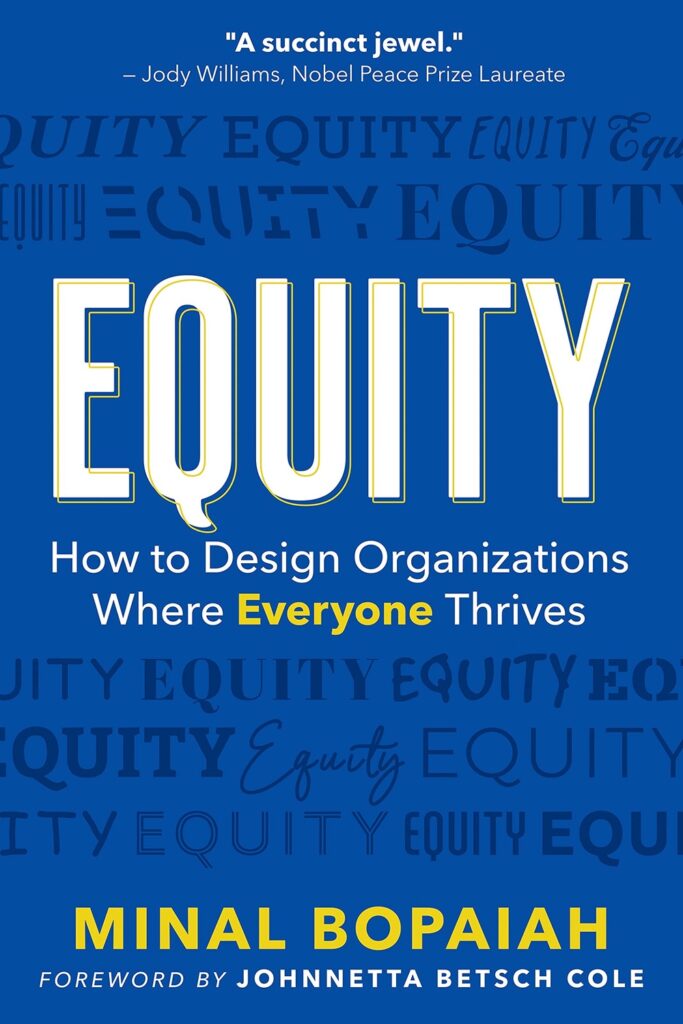Sharing my learnings from the book, Equity by Minaj Bopariah
Equity by Minaj Bopariah
Even the most passionate advocates for diversity, equity, and inclusion have been known to treat equity as the middle child—the concept they skip over to get to the warm, fuzzy feelings of inclusion. But Minal Bopaiah shows throughout this book that equity is critical if organizations really want to leverage differences for greater impact.
Equity allows leaders to create organizations where employees can contribute their unique strengths and collaborate better with peers. Bopaiah explains how leaders can effectively raise awareness of systemic bias and craft new policies that lead to better outcomes and lasting behavioral changes. This book is rich in real-world examples, such as managing partners at a consulting firm who learn to retell their personal stories of success by crediting their systemic advantages and news managers at NPR who redesign their processes to support greater diversity among news sources. This slender book expands DEI past human resources initiatives and shows how leaders can embed equity into core business functions like marketing and communications.
Filled with humor, heart, and pragmatism, Equity is a guidebook for change, answering the question of how that so many leaders are asking today.

- DEI – or diversity, equity, and inclusion – has become
something of a buzzword lately. Socially conscious leaders
refer to it as they scramble to fill positions with more women
and people of color. This is a great start, but it only focuses on the diversity and inclusion sides of DEl. The middle term – equity – tends to get shortchanged. This is a problem because equity is what ensures organizations give all employees the same opportunities to thrive. - people think equity is just a synonym for equality but they’re 2 different concepts. Equality is about ensuring that everybody has access to the same things. Equity, on the other hand, is about making room for difference.
- calling for diversity and inclusion is a toothless gesture – unless it’s backed up by equity. It’s not enough to fill roles with people from marginalized backgrounds; you also need to build structures that will accommodate people’s differences. If you want to create a truly fair and inclusive organization, you must think systemically.
- we can offset systemic bias by learning from human-centered design
- The human-centered approach focuses on the needs and experiences of the end user.
- what sets it apart is that the proponents of the human-centered design bring users into the whole process. They invite future users to contribute at every stage.
- human-centered design only works if you can emphathize with end users. Empathy meaning being willing to speak with people and listen to what they have to say
- equitable leaders adopt a system-oriented approach to change
- redesigning an organization for equity begins with leadership
- 3 conditions any equitable leader must meet: (1) have the right values (2) able to see systems and (3) must be humble enough to acknowledge how systemic advantages have contributed to their own success
- have your heart in the right place – this means being respectful, fair & approachable to all your staff & customers. More importantly, appreciating the value of difference
- humility – recognize that their success is based on advantages which other people might not have.
- publicly owning up to the systemic advantage – don’t reproduce the false narrative that success is all about effort. Tell your story in a way that unmasks inequity, by acknowledging the systemic advantages that have helped you get to where you are today.
- Organizations that intend to build equity needs to design systems that make equity effortless
- use nudges – little pointers that direct people toward doing the right thing.
- Automate decision-making.
- lots of options but they all usually involve reducing decision-making & turning equitable behavior into standard procedure
- leaders can do a lot to support positive change at their organization by becoming better at internal communications
- paying attention to the language you use
- leverage an approach called behavioral change communication (BCC). It’s been used to support public health initiatives.
- Steps in behavioral change communication (BCC) formula:
- identify the obstacles to change (risk perception)
- frame the message. Framing helps you break through psychological barriers
- target the behavior you want to change. Targeting is about moving people to take action. All you need to do is ask.
- To ensure your marketing output always contains positive and inclusive messaging, make use of the REACH model.
- Representation – Experience – Accessibility – Compensation – Harm reduction.
- tool for screening your marketing communications before you post them.
- check if your media content represents a range of different ethnic groups, genders and body types
- when creating content, always ask yourself: “do I really have the right experience to be addressing this issue?”. If not, invite those who do in your creative process
- accessibility – design your content for everybody
- make sure everybody who is involved in creating content is fairly compensated
- ask yourself: “is this content causing anyone harm?”. You want to consider giving your sources the right to revoke the use of their images or other personal data to protect their privacy.


Leave a Reply